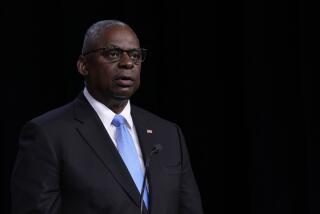From the archives: Hostage Spared; Role of Iran Seen as Pivotal
WASHINGTON -- The Bush Administration on Thursday began to seek ways to expand Iran’s apparently pivotal role in sparing the life of hostage Joseph J. Cicippio into a resolution of the five-year-old hostage crisis.
Although relieved U.S. officials still are trying to piece together the sequence of events that led to the “freezing” of the death threat against Cicippio, national security analysts said they have learned that key leaders in Lebanon of the radical Shiite Muslim movement Hezbollah were summoned Thursday to the Iranian Embassy in Damascus, Syria, and told that Iran wanted Cicippio’s life spared.
After that meeting, Cicippio’s Shiite captors announced that the deadline for executing him had been extended four hours. Later in the day, they said they were “freezing” the death sentence indefinitely, citing “intervention by some states and parties that were asked by the United States to mediate.”
Iran Role Could Be Opening
Iran’s involvement “could be” an opening toward eventually getting some or all of the hostages released, as well as toward a possible long-term improvement in relations with Iran, one Administration official said.
“It’s one small step,” this official said. “The optimists among us would like to believe (that) it might be enough to lead to more improvement.”
In an official statement, White House spokesman Marlin Fitzwater said: “We express our appreciation to all those who have been thus far trying to help.” But he went on to say that lifting the immediate death sentence for Cicippio “still does not answer our continuing concern for release of all hostages.”
In addition to Iran, U.S. officials also were crediting Syrian Presi-dent Hafez Assad, whose nation also has influence over radical Islamic groups in Lebanon, with playing a key role in forestalling the crisis.
State Department spokeswoman Margaret Tutwiler publicly acknowledged Syria’s efforts Thursday, saying that Damascus has assured U.S. officials of its intention to be “helpful.” Reflecting the Administration’s continued questions about Iran’s intentions, Tutwiler offered a more guarded assessment of Tehran’s role.
“At this time we have no reason to believe that Iran is not dealing with this matter in a serious way,” she said.
The announcement that the death threat against Cicippio had been suspended came at the end of an almost frenzied search by American officials for diplomatic channels that could be used to influence the radical Shiite factions that hold Cicippio and seven other U.S. hostages in Lebanon.
Bush Called Leaders
President Bush personally called several Middle Eastern leaders, including Algerian President Chadli Bendjedid, Saudi Arabia’s King Fahd, Jordan’s King Hussein and Morocco’s King Hassan II as well as Pope John Paul II and leaders in Turkey, Britain and West Germany. State Department officials also sent repeated messages to Iran through the Swiss, Japanese and Syrian embassies in Tehran, officials said.
While they awaited signs of a response, the government’s leading experts on Iran met at the State Department on Thursday for what one official called a “brainstorming session” about what to do next.
Options prepared by the Pentagon included possible military action. Asked about a report that Bush was prepared to order an air strike on an eastern Lebanon militant camp in Baalbek if Cicippio had been killed, Secretary of State James A. Baker III late Thursday said a full range of contingencies was held open. Focusing on one now, he said in a broadcast interview, would be “very hypothetical and very speculative.” White House spokesman Marlin Fitzwater said earlier in the day that no decision had been made on any particular action.
In the end, analysts said, the announcement on freezing the death sentence may have been at least partly tied to Hashemi Rafsanjani’s inauguration Thursday as Iran’s new president.
U.S. officials say they believe that Rafsanjani may be interested in improving relations with the United States as he seeks to right Iran’s war-battered economy and that he saw the hostage gesture as a worthwhile step.
Now, Administration officials say, they are looking for ways to continue this momentum, fearing that if it is lost, the hostages may again become pawns in internal Iranian power struggles.
The officials cautioned that, while Iran and Syria both have influence over the radical groups that hold the hostages, that influence is limited. The small Lebanese factions of the Hezbollah movement control the situation “like a faucet,” one senior official said. “The threat can be renewed in five minutes.”
The groups derive almost all of their power from the fact that they hold hostages. And many of them have individual motives that do not coincide with broader policy aims. In some cases, leaders of terrorist groups are seeking release of relatives held prisoner in other nations.
Still, one official said, Iran showed that it has “positive influence” on them. Hezbollah’s Shiite members consider themselves followers of Iran’s late leader, the Ayatollah Ruhollah Khomeini. Syria, by comparison, has “negative influence” because its army, which maintains as many as 40,000 troops in Lebanon, controls much of the territory in which Hezbollah operates, the official noted.
The Administration continues to believe that the best way out of the immediate crisis would be an Israeli-engineered swap in which hostages would be exchanged for Shiite detainees held by Israel and an influential Shiite clergyman the Israelis seized in Lebanon last week.
As a way of potentially increasing the pressure on the radical factions to negotiate with Israel over such a swap, the Administration is considering seeking the extradition of the clergyman, Sheik Abdel Karim Obeid, for trial in the United States, Fitzwater revealed.
Obeid, a figure in Hezbollah, is suspected of helping plan the 1987 kidnaping of Marine Lt. Col. William R. Higgins, whose captors claimed to have hanged him Monday. But Justice and State Department officials acknowledged that enough evidence for a solid criminal case against the sheik might not be available, because a confession he reportedly gave Israeli military authorities probably would not be considered voluntary. Extraditing Obeid and then having him go free for lack of a strong case would be “the worst possible outcome,” one official said.
U.S. officials reasserted Thursday that the government still stands by its policy of not negotiating with terrorist groups over hostages. But State Department spokeswoman Tutwiler confirmed that the Administration told Israeli authorities Monday that it would not object if they offered to swap Obeid for the hostages.
A deal, however, could easily founder on the complicated politics of Iran.
Arrayed against Rafsanjani is Iran’s powerful interior minister, Ali Akbar Mohtashemi, who has been closely allied with the Hezbollah militants. Analysts fear that the hostage crisis will give Mohtashemi influence as Rafsanjani tries to put together a new government. Mohtashemi is gaining leverage “at the last possible moment and, for the hostages, the worst possible time,” one analyst said.
Times staff writers Ronald J. Ostrow and Norman Kempster contributed to this story.
U.S. WARSHIP MOVEMENTS Pentagon has directed 14 warships to steam toward Lebanon and Iran Battleship Iowa ended its port call in Marseilles, France, could reach Lebanon by today. Guided missile cruiser Belknap, flagship of the U.S. 6th Fleet, canceled scheduled visit to Soviet Black Sea port. Aircraft carrier Coral Sea departed Alexandria, Egypt, earlier than planned, is now in the Mediterranean. Aircraft carrier America departed Singapore with eight escort ships, could be in Arabian Sea by Monday. 20-25 U.S. ships in the Mediterranean, including a 3-ship amphibious landing group with 2,400 Marines. 20 U.S. ships in the Persian Gulf and Indian Ocean. Pentagon officials, following normal policy, refused to divulge the ships’ or battle groups’ destinations.
Sources: Jane’s Fighting Ships 1987-88; U.S. Dept. of Defense
More to Read
Sign up for Essential California
The most important California stories and recommendations in your inbox every morning.
You may occasionally receive promotional content from the Los Angeles Times.










